Sabarimala Ayyappa temple and pilgrims getting ready for Makara vilakku festival
Read this article to know about what is Sabarimala Makara vilakku festival, Sabarimala vilakku, Makara Samkramam, Makara Jyoti at Sabarimala, the confusion on the Makara vilakku and the Makara Jyoti, Thiruvabharanam of Lord Ayyappan, The mysteries connected with Sabarimala, Erumeli Petta Thullal, Malikappuram Procession and the Guruthi Ritual being held at the hill shrine of Sabarimala as a part of the Makara vilakku festival.
What is Sabarimala Makara vilakku festival?
The rituals carried on the day of Makara Samkramam (also called the Makara Samkranthi or Makara Samkramanam) culminating in the Makara vilakku is called the Makara vilakku festivals of Sabarimala. The Makara vilakku is the lighting of the camphor at Ponnambala medu, a hill near the Sabarimala shrine at around 6.30 p m on the Samkranthi day. This is visible at the Sabarimala at a distance of 4 km as the quantity of camphor used is so huge. The Sabarimala Ayyappan temple is the 2nd most pilgrims visited temple of South India after the first one of Thirupathi Tirumala Temple. It is estimated that an approximate 50 to 75 million pilgrims visit this temple in a year. This is in spite of the fact that it is situated on a hill in the midst of an expansive thick rain forest on the Western Ghats very difficult access. One of the most important festivals at the Sabarimala Ayyappa Temple is the Makaravilakku. Makaravilakku (Makara vilakku means the light of the month of Makaram). Normally the Makaravilakku falls on the 14th of January every year. But this year it falls on the 15th. On this day the crowd at the Sabarimala hill shrine of Lord Ayyappa will be around one and half a million to about 1.75 million. These devotees congregate here for the darshan (glance) of the Makara Jyoti and of the deity of Lord Ayyappa. Makara is the name of a Malayalam month (known as Capricorn Zodiac in English) and vilakku means lighted lamp. This lighting of the lamp at the change of the month from Dhanu to Makaram is called as the Makara Vilakku. The temple will show the camphor deeparadhana (camphor aarti) around 6.30 pm. This is the day on which the temple performs the most important rituals. However, this year the Makara vilakku falls on the 15th of January. Sabarimala Makara vilakku
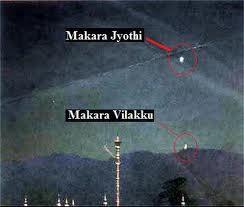
The Makara vilakku is the ritualistic light of the lamp on the Ponnambalamedu (a hill called by that name), the hill next to the sanctum sanctorum of Sabarimala on the Makara Sankranthi day. This can be seen around 4 -5 km radius. Makara vilakku is the most important day in the Sabarimala temple. On this day maximum crowd of devotees will congregate at the hill shrine. Last year it was around 1.5 million devotees. Usually it falls on the 14th of January evening. The main rituals start on the evening of 14th and continue till 15th. On 14th evening the ritual of lighting of Makara Vilakku will be performed and the lamps all around the temple also will be lit. This year the Makara vilakku falls on the 15th. On this day the people connected with the Sabarimala Ayyappan temple light a fire made of a huge heap of camphor in a huge bowl on the Ponnambala medu (hill). It is similar to the light of huge lamp, Annamalai Deepam on Karthika Pournami day. Only difference is in Ponnambala medu it is of camphor and in Annamalai it is of oil and cloth wicks. In Annamalai it light will be continuous where on is Ponnambalamedu it is for few seconds 3 times. This light will be visible to the devotees who are at the Sabarimala shrine and around. With all the lamps lit at the Sabarimala Temple and the Camphor lighted at the Ponnambala medu, this festival is called Makara vilakku. This lighting of the camphor is done in such a way that the glow appears 3 times. Since the quantity of camphor lighted is so huge that the light is visible at the Sabarimala hill shrine which is about 4 k m away. For making it to appear thrice, the people allow the camphor to burn for few seconds and then douse the camphor fire with wet gunny bags and repeat this action thrice. The light is finally doused after the Thiruvabharanam (the divine ornaments and jewels belonging to the Lord Ayyappan) is brought from the Panthalam (also spelt as Pandalam) Place into the sanctum sanctorum and is adorned on Lord Ayyappan. Makara Samkramam
The Makara Samkramanam (Sankranthi) is a very important day for the entire Hindu community. This happens at the transition of the Sun from the Dhanu Zodiac (month) to enter Makara Zodiac. This is known as the Makara Snakramam. The Utharayana holy period of 6 months start from this day. In Hindu custom a year is divided into 2 parts known as Ayanams. One half of the year is Utharayanam (Uttara Ayanam) when the sun travels in the Northern hemisphere (celestial sphere). Utharayanam starts from Makara Sankranthi (Snakramam – Sankramanam) and ends by Karkataka (Kataka) Snakramam. Similarly when the Sun travels in the Southern hemisphere from Kataka Samkranthi to Makara Samkranthi it is Dakshinayanam. These two Samkranthis are very important days in Hindu calendar throughout the country. For Kerala also these 2 Samkranthis are very important. Makara sankranthi is considered as a very auspicious day for all good things to start. The Kataka Sankranthi is considered good mainly for offering Bali (sacrifice or Tharpana) to the diseased ancestors. The earth rotates on its own axis and also moves around the sun take one month to cross from one zodiac to another. For those seeing superficially, it will appear that the Sun is moving just as we look through the window of moving vehicle the place appear to be crossing us. In one year it completes one circle of the movement. That means every month the Sun appears to cross from one zodiac to another. The day on which the sun changes the zodiac is the called as the sankranthi (transit). Makara Sankranthi (Sun's transition into the Makaram – Capricorn zodiac) usually on 14th January of English Calendar is known by different names in different languages. In Sanskrit and Malayalam and many other languages it is known as Makara Sankranthi. In Tamil it is known as Thai Pongal. Makara Jyoti at Sabarimala
Makara Jyoti is the celestial star that appears at the Samkramanam time of Makara masam (zodiac – month). When the Sun enters the zodiac of Makaram, a star Makaram Nakshatram appears in the sky. This is a natural phenomenon. That is not directly connected with the Sabarimala Makara vilakku festival. The only connection with this star and the festival is that the appearance of the star coincides with the culmination of the Makara vilakku festival of the Sabarimala temple. The devotees worship the celestial light - the Makara Jyoti the star that appears in the sky at the Makara Samkramanam and also the Makara vilakku that is lit by human beings in and around the temple and at the Ponnambala medu. Confusion on Makara vilakku and Makara Jyoti
There used to be confusion from the year 1981on wards till the year 2008 that Makara vilakku and Makara Jyoti is one and the same. But on 28-5- 2008 the grandson of the Chief priest of Sabarimala Sri Rahul Eswar clarified in a press statement that the Makara vilakku and the Makara Jyoti are not one and the same but are 2 different incidents. Makara vilakku is the light made by human beings by lighting camphor and the Makara Jyoti is a natural event taking place at identical time. The Government of Kerala State also cleared the confusion by confirming that the light at Ponnambala medu mistakenly believed by people as 'Makara Jyoti' is man made and there is no mystery or superstition attached to it. Until this clarification the devotees and others used to be under the belief that the light is a divine light like the Makara Jyoti a natural miracle. There used to be communications between the temple priest and the people at the Ponnambala medu who are lighting the camphor to co-ordinate. The Ponnambala medu is under the custody and control of the Kerala State Electricity Board (KSEB).
The 2008 revelation of the 'Makara Jyoti' is not divine but man made did not make much difference to the number of pilgrims visiting the temple. The total collection of the temple also did not come down and is about Rs 750 million per year.
Even now the devout Hindus believe that the sight at the Sabarimala on the Makara Samkranthi day is divine and celestial. The Makara vilakku is being performed in the temple in memory of the aarathi performed by the Devarishis and Devdas. They did this aarathi at the moment of the revelation of Manikantan of his divine form to them as Lord Ayyappan or Sri Dharma Sastha, an incarnation of Lord Vishnu.
Thiruvabharanam of Lord Ayyappan
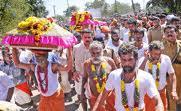
The ornaments and jewels used by Manikantan (who later became the Sri Dharma Sastha or Ayyappan) when he was in the Panthalam Palace as the prince, will be sent to the Ayyappan temple so as to reach the temple before the Makara Snakramam so as to adorn the Lord with these. Lord Ayyappan was the foster son of the Panthala Raja. When the difficult period of the kingdom was solved by Manikantan (later became Lord Ayyappan) he decided to renounce and perform penance in a lonely place where it will not be easy for the human beings to go and disturb him which is the present Sabarimala temple. The then king who was the foster father of Manikantan could not dissuade Manikantan from the path of going out and doing penance. So he expressed the desire of seeing Manikantan at least once a year. Manikantan agreed to this request. The ornaments of Manikantan were in the palace as the same was not required by Manikantan for penance in the forest. But the Raja used to take the same with him when go to visit Manikantan in the forest at Sabarimala and compel him to wear them for the Raja to see him in his earlier form as Manikantan, the prince. That practice is followed even now though the foster parents died long back. The successive generations of continued the practice. The divine ornaments popularly known as the Thiruvabharanam of the Lord were sent to the temple. The priests adorn the Lord with these ornaments on the Makara Samkranthi time even if the Rajas do not visit the temple. The Thiruvabharanam (divine ornaments and jewel) will be carried in a procession from the Panthalam Palace Valiakoickal Sri Dharma Sastha Temple at 1 pm on the 13th of January to Sabarimala visiting some important temples en route. In some of these places the boxes containing the Thiruvabharanam will be offered pooja and the carriers and the persons accompanying the same will be taking rest and have their food. Just before the Samkramam the Lord will be bedecked with the Thiruvabharanam and right on dot of the Samkramam the door of the sanctum sanctorum will open and aarathi (deeparadhana) will be performed to the lord to the excited devotion of the devotees. This sight will be a sumptuous feast for devotees' spiritual mind.
The deeparadhana to the lord as mentioned earlier after adorning the Thiruvabharanam will be performed on the 14th January at 6.30 pm.'Makarasamkrama Pooja' the most auspicious pooja of the temple will be done to the Lord Ayyappan at the temple at 12.58 am on the 15th of January. The mysteries connected with Sabarimala
One of the greatest believed mysteries was that connected with the Makara Jyoti. The light on the Ponnambala medu was believed as a great celestial mystery occurring at the Samkramam. But with the revelation by the grandson of the chief priest and the Government has removed this mystery.
There is another mystery connected with the Thiruvabharanam procession. When the Thiruvabharanam petty (box containing the divine ornaments of the Lord) starts from Panthalam a Garuda (golden eagle – Krishna Parunthu) escorts the same from the Panthalam Royal Palace to the Sabarimala temple. This feat is seen every year at the same time. When the lord is adorned with the Thiruvabharanam the eagle disappears and come back when the ornaments are taken from the temple to the Panthalam Palace.
Erumeli Petta Thullal
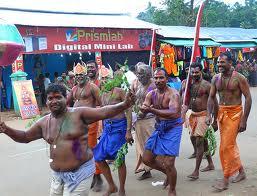
One of the rituals connected with the Makara Vilakku festival of Sabarimala is the Petta Thullal (a type of dance by the devotees of the Lord). Every year this happens on the 12th January. There are 2 main groups to perform the petta dance. The Ambalapuzha team will do the petta thullal on seeing the Krishna Parunthu (golden eagle) in the sky at mid day (12 noon) from the Erumeli Kochambalam to the Erumeli Sri Dharma Sastha Temple. At 2 pm the next team from Alangattu will do the Petta thullal on seeing the star in the sky from the Kochambalam to Sri Sastha temple. Malikappuram Procession
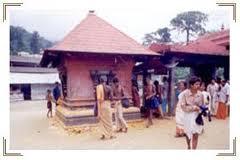
After the Makara vilakku festival a procession festival carrying the thidambu (representation) of the deity Malikapurathamma at the right of the Lord's shrine will be taken out. The idol of the Devi will be carried on the back of a caparisoned elephant. This festival will be held from the 15th to 19th January. Guruthi Ritual at Sabarimala shrine
Every year a guruthi ritual will be held on the 20th of January at 11 pm at Malikappuram Temple and the temple will close on 21st January. The Lord Ayyappan temple will be closed at 7 am on January 21st after the representatives of the Pandalam Raja have darsan of the Lord.Miscellaneous tit bit information
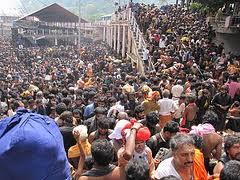
During the last year Makara vilakku festival time 102 pilgrims were killed in a stampede. The devotees congregated on the Pulmedu to witness the Makaravilakku and were returning after seeing the Makara vilakku when the stampede took place from there.
The income till middle of November, 2011 in the temple was Rs 114.86 crores. This amount is
more by 20.16 crores from the last year's collection for the same period.
On the controversy of the flickering light seen at the eastern side of Sabarimala, the temple authorities have clarified the position. According to them this light is nothing but the deeparadhana (camphor aarathi performed by a priest on the Ponnambala medu during the Makara Samkramam pooja at the temple. This is a part of the rituals at the hill shrine of the Lord Ayyappan.

 Job oriented
Job oriented